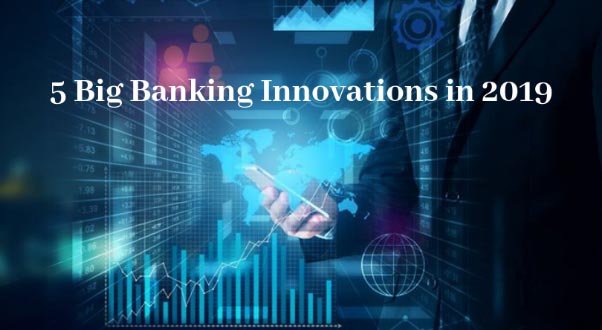5 big Banking innovations in 2019
Updated On : July 2019
The banking sector worldwide is becoming more focused strategically besides making huge advancement in technology. This is helping them to meet customer expectations while also defending market share against increasing competition.
New innovations and developing new solutions by taking advantage of data, advanced analytics, digital technologies and new delivery platforms have become critical. 2019 has seen the banking industry innovate in different areas and incorporate the traits and practices that were once the trademark of fintech start-ups. Banks and credit unions are innovating faster by targeting, expanding their services, delivering proactive advice, re-configuring delivery channels, integrating payments and using blockchain technology.
Let us look at the top 5 of the big innovations of 2019
Expanding Open Banking
An increasing number of regulatory bodies globally are making it mandatory for banking organizations to allow customers to share their data securely with third parties in a move to boost new financial services and enhance the competition in the banking industry. Consumers have more freedom and control in the interaction with their financial service providers with account and payment data being made available through secure application programming interfaces (APIs).
Open banking APIs boost innovation and collaboration, and lead to growing banking ecosystems to make a consumer's lifestyle better with more than just financial services. Because of consumer consent being a core part of open banking strategy, there is an increased emphasis on consumer value proposition with the firms offering innovative solutions becoming the relationship winners.
Giving consumers choice and control of their own data, first-mover banks and credit unions can become the mavericks of personalized financial services. The growth of open banking will also push non-traditional financial firms to collaborate with traditional banks and innovate for the consumer.
Commitment to Physical and Digital Delivery
An increasing number of traditional financial services companies are introducing digital only banking entities, as a lot of transactions are moving to digital channels and also to combat the high cost of a traditional branch network. From launching digital-only banks to collecting deposits, to using digital platforms for lending, investing and speciality services, banks and financial firms are focusing on quality customer experiences and increased value for customers. These organizations are aiming to protect their current customer base, while others are trying to expand their market share by introducing first-to-market products that are consumer-focused.
Thus, client expectations and the cost of alternative forms of delivery are factors that play an important part in structuring the banking industry and bringing in innovative new delivery models.
AI-Driven Predictive Banking
One of the most exciting innovations in 2019 is predictive banking. For the first time, the banking industry is consolidating all internal and external data and building predictive profiles of customers in real time. With rich, accurate and financially viable consumer data, financial institutions know their customers very well and are able to offer advice for the future, while increasing security and efficiency.
With robo-advisors and AI-driven Chatbots, financial institutions offer 'next-best actions' with personalised solutions in real time and universal cash management solutions that address implicit needs in an integrated service. Information with figures and insights are contextually delivered with the aim of proactively changing customers' behavioural patterns.
Customers are taking more control of their data
In the past and till date, banks, lending institutions and credit bureaus have been selling and sharing consumers' financial data without the consumers' knowledge or consent while data aggregators gather information without the consent of financial services providers.
However these practices are set to disappear. A significant number of consumer banking accounts come with controls that let consumers choose which third parties can access their data and how. This is due to the larger banks implementing application programming interfaces with such controls built in. Some fintechs are also testing apps that allow customers greater control over how third parties use their data. A few innovative financial organizations are setting up ways to enable their customers to sell their own information.
Smaller banks are also seeking to find ways to allow consumers a say in the sharing of their data with third parties, with the cooperation of their core banking vendors.
Finally, the European Union's General Data Protection Regulation makes it mandatory for financial and other companies registered inside the EU and foreign firms that operate in EU to ask consumers for explicit consent before using their data or sharing it with others.
Cardless ATM service
For the first time in the world, BankDhofar in Oman has launched a cardless banking service for ATMs which allows customers to carry out ATM transactions effortlessly by using only their mobile numbers. For this service, customers need to activate their mobile number through the BankDhofar call centre or their mobile banking app. Once verified, customers can go to the nearest BankDhofar ATM and insert their mobile number, one-time PIN (OTP) and the card PIN, and carry out their transaction. Cardless banking allows customers to withdraw cash, pay bills, request for cheque book, make balance inquiry, and request for a mini statement.
While BankDhofar may be the pioneer to launch Cardless ATM services and improved their customers' experience, it won't be long before other banks offer the same or even go a step ahead with more innovations added to the service.
Leave Comments :
Latest Blog
-
 Driving Rural Financial Inclusion with Lending Management Software Updated
On : June 2025
Driving Rural Financial Inclusion with Lending Management Software Updated
On : June 2025
-
 The Rise of AI in Credit Risk and Lending Software Updated
On : July 2025
The Rise of AI in Credit Risk and Lending Software Updated
On : July 2025
-
 Green Lending: ESG Metrics Embedded in Lending Software Updated
On : July 2025
Green Lending: ESG Metrics Embedded in Lending Software Updated
On : July 2025
-
 The Role of Blockchain in Modern Lending Management Software Updated
On : July 2025
The Role of Blockchain in Modern Lending Management Software Updated
On : July 2025
-
 Ensuring Compliance in Loan Origination Software Updated
On : June 2025
Ensuring Compliance in Loan Origination Software Updated
On : June 2025



Comments :